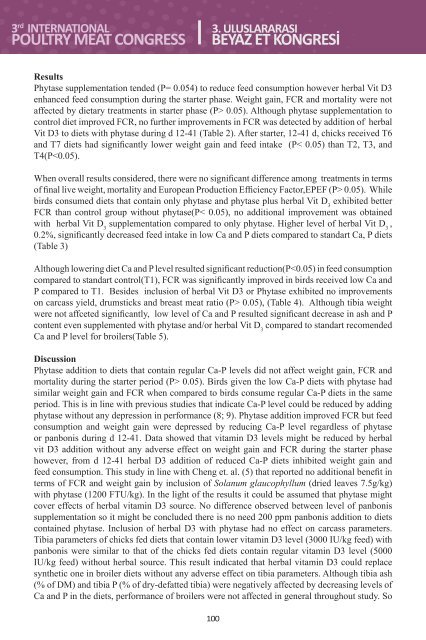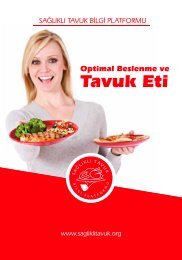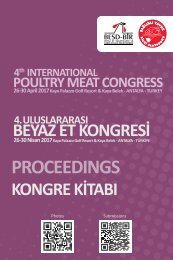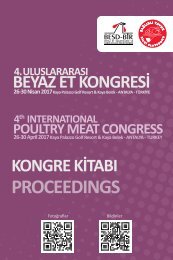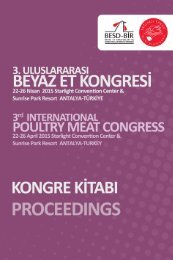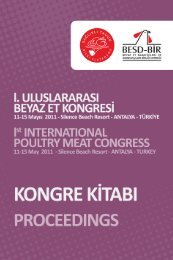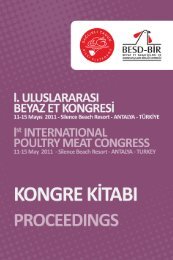3rd International Poultry Meat Congress
Proceedings
Proceedings
You also want an ePaper? Increase the reach of your titles
YUMPU automatically turns print PDFs into web optimized ePapers that Google loves.
Results<br />
Phytase supplementation tended (P= 0.054) to reduce feed consumption however herbal Vit D3<br />
enhanced feed consumption during the starter phase. Weight gain, FCR and mortality were not<br />
affected by dietary treatments in starter phase (P> 0.05). Although phytase supplementation to<br />
control diet improved FCR, no further improvements in FCR was detected by addition of herbal<br />
Vit D3 to diets with phytase during d 12-41 (Table 2). After starter, 12-41 d, chicks received T6<br />
and T7 diets had significantly lower weight gain and feed intake (P< 0.05) than T2, T3, and<br />
T4(P 0.05). While<br />
birds consumed diets that contain only phytase and phytase plus herbal Vit D 3<br />
exhibited better<br />
FCR than control group without phytase(P< 0.05), no additional improvement was obtained<br />
with herbal Vit D 3<br />
supplementation compared to only phytase. Higher level of herbal Vit D 3<br />
,<br />
0.2%, significantly decreased feed intake in low Ca and P diets compared to standart Ca, P diets<br />
(Table 3)<br />
Although lowering diet Ca and P level resulted significant reduction(P 0.05), (Table 4). Although tibia weight<br />
were not affceted significantly, low level of Ca and P resulted significant decrease in ash and P<br />
content even supplemented with phytase and/or herbal Vit D 3<br />
compared to standart recomended<br />
Ca and P level for broilers(Table 5).<br />
Discussion<br />
Phytase addition to diets that contain regular Ca-P levels did not affect weight gain, FCR and<br />
mortality during the starter period (P> 0.05). Birds given the low Ca-P diets with phytase had<br />
similar weight gain and FCR when compared to birds consume regular Ca-P diets in the same<br />
period. This is in line with previous studies that indicate Ca-P level could be reduced by adding<br />
phytase without any depression in performance (8; 9). Phytase addition improved FCR but feed<br />
consumption and weight gain were depressed by reducing Ca-P level regardless of phytase<br />
or panbonis during d 12-41. Data showed that vitamin D3 levels might be reduced by herbal<br />
vit D3 addition without any adverse effect on weight gain and FCR during the starter phase<br />
however, from d 12-41 herbal D3 addition of reduced Ca-P diets inhibited weight gain and<br />
feed consumption. This study in line with Cheng et. al. (5) that reported no additional benefit in<br />
terms of FCR and weight gain by inclusion of Solanum glaucophyllum (dried leaves 7.5g/kg)<br />
with phytase (1200 FTU/kg). In the light of the results it could be assumed that phytase might<br />
cover effects of herbal vitamin D3 source. No difference observed between level of panbonis<br />
supplementation so it might be concluded there is no need 200 ppm panbonis addition to diets<br />
contained phytase. Inclusion of herbal D3 with phytase had no effect on carcass parameters.<br />
Tibia parameters of chicks fed diets that contain lower vitamin D3 level (3000 IU/kg feed) with<br />
panbonis were similar to that of the chicks fed diets contain regular vitamin D3 level (5000<br />
IU/kg feed) without herbal source. This result indicated that herbal vitamin D3 could replace<br />
synthetic one in broiler diets without any adverse effect on tibia parameters. Although tibia ash<br />
(% of DM) and tibia P (% of dry-defatted tibia) were negatively affected by decreasing levels of<br />
Ca and P in the diets, performance of broilers were not affected in general throughout study. So<br />
100


